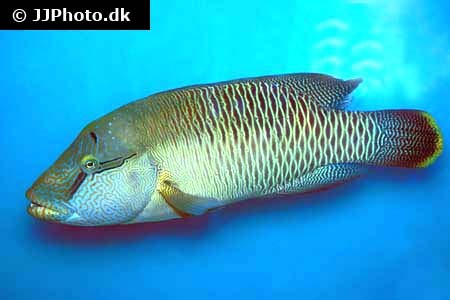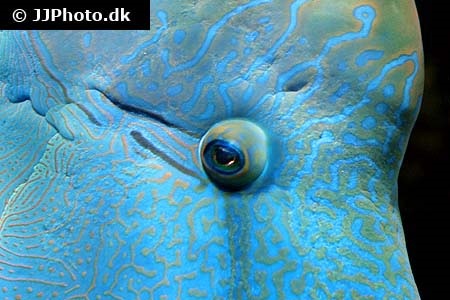Cheilinus undulatus
| Latin name | Cheilinus undulatus - Rüppell, 1835 |
|---|---|
| Local name | Humphead wrasse |
| Family | Labridae - Cheilinus |
| Origin | East Indian Ocean, West Indian Ocean, Australia, The Red Sea, Indonesia, East Pacific, Central/West Pacific |
| Max length | 229 cm (90.2") |
| Minimum volume | Unknown |
|---|---|
| Hardiness |
Average |
| Suitable for aquarium |
Not suitable for home aquarium |
| Reef safe |
Not reef safe |
| Aggressiveness | Might be aggressive towards other species |
| Recommended |
Fish Larger crustaceans (Shrimp, crabs...) Other invertebrates Small crustaceans (Krill, mysis, artemia...) |
|---|
This species is endangered.
These fish will hunt crustaceans, sea urchins and worms in an aquarium, very effectively.
This species needs good hiding places, for example, between live rocks.
This species revels in swimming and requires an aquarium with ample space.
This species can change gender from female to male.
When a male is needed, a female changes sex and takes on the role.
Fish in the genus Cheilinus are larger than most Wrasses, even up to 6.5 foot (2 metres).
These fish are a threat to most invertebrates -but not corals- and small fish. It is probably necessary to feed with living foods at first and after some time with large pieces of seafood every, or every other day.
It must be noted that even though they can be aggressive themselves when first introduced. They can easily be stressed by other fish, or indeed aquarists, before they are properly acclimatized.
Wrasses are nearly always seen in reef aquaria, since many of the species are both attractive and useful in battling a range of unwanted invertebrates like i.e. flatworms, pyramide snails.
These fish live of everything from zooplankton to large crustaceans, sea urchins and the like.
The needs and behaviour of Wrasses vary greatly, so it is vital to familiarize oneself with the specific species before buying one.
| Aquarium trade | Yes |
|---|---|
| Distribution | Indo-Pacific: Red Sea to South Africa (Ref. 35918) and to the Tuamoto Islands, north to the Ryukyu Islands, south to New Caledonia. Formerly known as Vulnerable (A1d+2cd) (Y. Sadovy) but now listed as Endangered in IUCN 2004 and listed in Appendix II of |
| English common names |
Humphead Maori wrasse Humphead maori wrasse Humphead wrasse Double-headed maori wrasse Giant maori wrasse Giant humphead wrasse Humhead wrasse Napoleon wrasse |
| French common names |
Kakatoi vareur Napoléon |
| Danish common names |
Napoleonsfisk |
Scott Michael. 2004. Aquarium Fish: The Cheeklined Maori Wrasse, Cheilinus diagrammus - Advanced Aquarist - (English)
Bob Fenner. Maori/Splendour Wrasses, the Genera Cheilinus & (to): Oxycheilinus - Wet Web Media - (English)
Scott W. Michael. 2009. Wrasses and Parrotfishes (Reef Fishes Series Book 5) - TFH Publications / Microcosm Ltd. - (English)





